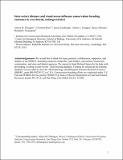Files in this item
Inter-aviary distance and visual access influence conservation breeding outcomes in a territorial, endangered bird
Item metadata
| dc.contributor.author | Flanagan, Alison M. | |
| dc.contributor.author | Rutz, Christian | |
| dc.contributor.author | Farabaugh, Susan | |
| dc.contributor.author | Greggor, Alison L. | |
| dc.contributor.author | Masuda, Bryce | |
| dc.contributor.author | Swaisgood, Ronald R. | |
| dc.date.accessioned | 2021-02-04T00:39:19Z | |
| dc.date.available | 2021-02-04T00:39:19Z | |
| dc.date.issued | 2020-02-04 | |
| dc.identifier | 266186878 | |
| dc.identifier | 088039da-db5b-4343-b5a2-4abb55c5edfb | |
| dc.identifier | 85078795779 | |
| dc.identifier | 000517855100026 | |
| dc.identifier.citation | Flanagan , A M , Rutz , C , Farabaugh , S , Greggor , A L , Masuda , B & Swaisgood , R R 2020 , ' Inter-aviary distance and visual access influence conservation breeding outcomes in a territorial, endangered bird ' , Biological Conservation , vol. 242 , 108429 . https://doi.org/10.1016/j.biocon.2020.108429 | en |
| dc.identifier.issn | 0006-3207 | |
| dc.identifier.other | ORCID: /0000-0001-5187-7417/work/68647878 | |
| dc.identifier.uri | https://hdl.handle.net/10023/21370 | |
| dc.description | Funding for setting up the housing database was provided by the UK’s Biotechnology and Biological Sciences Research Council (BBSRC; grant BB/G023913/2 to C.R.). | en |
| dc.description.abstract | Species extinctions are becoming a global crisis, affecting biodiversity and ecosystem services, with island populations being particularly vulnerable. In response, conservation managers are increasingly turning to ex situ conservation breeding programs to establish assurance populations and provide a source for release and re-establishment of wild populations. The 'Alalā (Hawaiian crow, Corvus hawaiiensis) is a critically endangered and territorial island corvid that became extinct in the wild in 2002, following a severe and prolonged population decline during the late 20th century. Surviving individuals of the species were brought into captivity to establish an assurance population to serve as a source for reintroduction, which commenced in 2016. We analyzed the extent to which a range of captive housing conditions impact 'Alalā reproductive success, using 19 years of breeding program data. We found that reproductive success was most strongly affected by the distance between aviaries and their closest neighbors and whether breeding pairs had visual access to other adult conspecifics. Pairs located in aviaries that were more spatially isolated and without visual access to conspecifics were more likely to produce fertile eggs than pairs housed in aviaries that were closer to others or those with visual access to other birds. Our results have direct management implications relevant to the design of conservation breeding centers geared towards the recovery of endangered, territorial bird species. Moreover, since suboptimal housing conditions can increase stress levels in captive birds, our findings are also relevant to improving animal welfare for 'Alalā and other species in conservation breeding programs. | |
| dc.format.extent | 763157 | |
| dc.language.iso | eng | |
| dc.relation.ispartof | Biological Conservation | en |
| dc.subject | Animal husbandry | en |
| dc.subject | Conservation breeding | en |
| dc.subject | Endangered birds | en |
| dc.subject | Social density | en |
| dc.subject | Enclosure design | en |
| dc.subject | Hawaiian crow | en |
| dc.subject | QH301 Biology | en |
| dc.subject | NDAS | en |
| dc.subject.lcc | QH301 | en |
| dc.title | Inter-aviary distance and visual access influence conservation breeding outcomes in a territorial, endangered bird | en |
| dc.type | Journal article | en |
| dc.contributor.sponsor | BBSRC | en |
| dc.contributor.institution | University of St Andrews. Centre for Biological Diversity | en |
| dc.contributor.institution | University of St Andrews. Centre for Social Learning & Cognitive Evolution | en |
| dc.contributor.institution | University of St Andrews. School of Biology | en |
| dc.identifier.doi | 10.1016/j.biocon.2020.108429 | |
| dc.description.status | Peer reviewed | en |
| dc.date.embargoedUntil | 2021-02-04 | |
| dc.identifier.grantnumber | BB/G023913/2 | en |
This item appears in the following Collection(s)
Items in the St Andrews Research Repository are protected by copyright, with all rights reserved, unless otherwise indicated.

